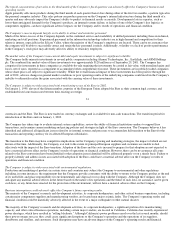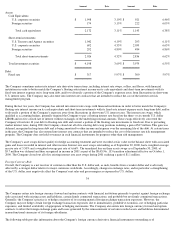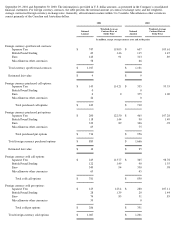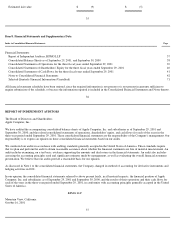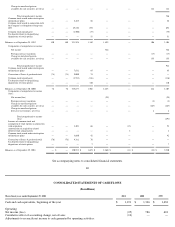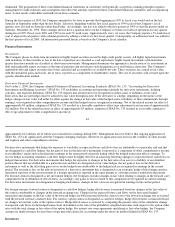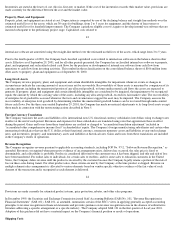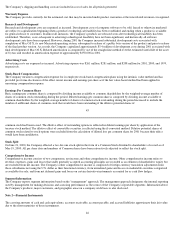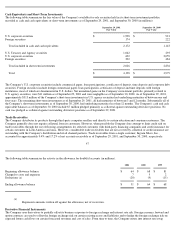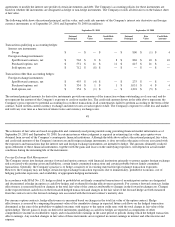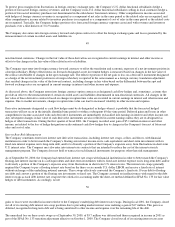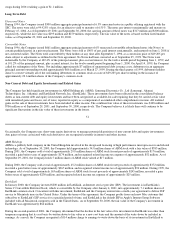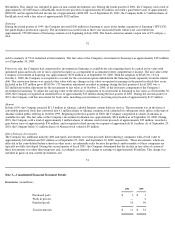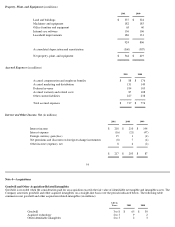Apple 2001 Annual Report Download - page 35
Download and view the complete annual report
Please find page 35 of the 2001 Apple annual report below. You can navigate through the pages in the report by either clicking on the pages listed below, or by using the keyword search tool below to find specific information within the annual report.
Inventories are stated at the lower of cost (first-in, first-out) or market. If the cost of the inventories exceeds their market value, provisions are
made currently for the difference between the cost and the market value.
Property, Plant, and Equipment
Property, plant, and equipment are stated at cost. Depreciation is computed by use of the declining balance and straight-line methods over the
estimated useful lives of the assets, which are 30 years for buildings, from 2 to 5 years for equipment, and the shorter of lease terms or
estimated useful lives for leasehold improvements. The Company capitalizes eligible costs to acquire or develop internal-use software that are
incurred subsequent to the preliminary project stage. Capitalized costs related to
43
internal-use software are amortized using the straight-line method over the estimated useful lives of the assets, which range from 3 to 5 years.
Prior to the fourth quarter of 2001, the Company had classified capitalized costs related to internal-use software on the balance sheet in other
assets. Effective as of September 29, 2001, and for all other periods presented, the Company has reclassified internal-use software to property,
plant, and equipment and reclassified related cash flows for the purchase or development of internal-use software from cash flow from
operations to cash flow from investing activities. This resulted in the reclassification on the consolidated balance sheets of $106 million from
other assets to property, plant and equipment as of September 30, 2000.
Long-Lived Assets
The Company reviews property, plant, and equipment and certain identifiable intangibles for impairment whenever events or changes in
circumstances indicate the carrying amount of an asset may not be recoverable. Recoverability of these assets is measured by comparison of its
carrying amount, including the unamortized portion of any allocated goodwill, to future undiscounted cash flows the assets are expected to
generate. If property, plant, and equipment and certain identifiable intangibles are considered to be impaired, the impairment to be recognized
equals the amount by which the carrying value of the assets, including any allocated goodwill, exceeds its fair market value. The recoverability
of enterprise level goodwill is assessed whenever the facts and circumstances suggest the asset may be impaired. The Company assesses the
recoverability of enterprise level goodwill by determining whether the unamortized goodwill balance can be recovered through undiscounted
future cash flows. For the three years ended September 29, 2001, the Company has made no material adjustments to its long-
lived assets except
those made in connection with the restructuring actions described in Note 5.
Foreign Currency Translation
The Company translates the assets and liabilities of its international non-U.S. functional currency subsidiaries into dollars using exchange rates
in effect at the end of each period. Revenues and expenses for these subsidiaries are translated using rates that approximate those in effect
during the period. Gains and losses from these translations are credited or charged to "accumulated translation adjustment" included in
"accumulated other comprehensive income (loss)" in shareholders' equity. The Company's foreign manufacturing subsidiaries and certain other
international subsidiaries that use the U.S. dollar as their functional currency, remeasure monetary assets and liabilities at year-end exchange
rates, and inventories, property, and nonmonetary assets and liabilities at historical rates. Gains and losses from these translations are included
in the Company's results of operations.
Revenue Recognition
The Company recognizes revenue pursuant to applicable accounting standards, including SOP No. 97-2, "Software Revenue Recognition," as
amended. Revenue is recognized when persuasive evidence of an arrangement exists, delivery has occurred, the sales price is fixed or
determinable, and collectibility is probable. Product is considered delivered to the customer once it has been shipped, and title and risk of loss
have been transferred. For online sales to individuals, for certain sales to resellers, and for some sales to education customers in the United
States, the Company defers revenue until the product is received by the customer because the Company legally retains a portion of the risk of
loss on these sales during transit. For other product sales, these criteria are met by the Company at the time product is shipped. Revenue on
multiple element sales arrangements is allocated to various elements based on vendor specific objective evidence of the fair value of each
element of the transaction and is recognized as each element is delivered.
44
Provisions are made currently for estimated product returns, price protection, rebates, and other sales programs.
In December 1999, the Securities and Exchange Commission issued Staff Accounting Bulletin (SAB) No. 101, "Revenue Recognition in
Financial Statements" (SAB 101). SAB 101, as amended, summarizes certain of the SEC's views in applying generally accepted accounting
principles to revenue recognition in financial statements and provides guidance on revenue recognition issues in the absence of authoritative
literature addressing a specific arrangement or a specific industry. The Company adopted SAB 101 in the first quarter of fiscal year 2001.
Adoption of this guidance did not have a material impact on the Company's financial position or results of operations.
Shipping Costs


